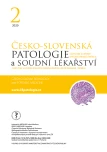Pathophysiology of ANCA-associated vasculitis
Authors:
Bartoňová Lenka 1; Hrušková Zdenka 2; Honsová Eva 1
Authors‘ workplace:
Pracoviště klinické a transplantační patologie, Transplantcentrum IKEM, Praha
1; Klinika nefrologie 1. LF UK a VFN v Praze, Praha
2
Published in:
Čes.-slov. Patol., 56, 2020, No. 2, p. 65-67
Category:
Reviews Article
Overview
ANCA positive vasculitis (AAV) is a serious autoimmune disease mainly affecting small vessels in various organ systems, accompanied by the presence of ANCA antibodies in serum. AAV represents a group of the most common systemic vasculitis in adulthood, and based on clinical manifestations this disease entity includes 3 phenotypes, namely: granulomatosis with polyangiitis (formerly Wegener‘s granulomatosis), microscopic polyangiitis and eosinophilic granulomatosis with polyangiitis (formerly Churg-Strauss syndrome). Similar to other autoimmune diseases, AAV develops in patients with a predisposing genetic background who have been exposed to causative environmental factors, such as infections. The mechanisms by which ANCA antibodies cause vasculitis involves excessive neutrophil activation, that subsequently leads to release pro-inflammatory cytokines, reactive oxygen species and lytic enzymes. In addition, activated neutrophils induce the formation of neutrophil extracellular traps in a process called NETosis. The released neutrophil antigens are exposed to the immune system via antigen presenting cells, which further stimulates antibody production and creates a vicious circle with tissue destruction.
Understanding the pathogenesis of AAV represents the key which provides not only optimal diagnosis and treatment, but also gives the pathologist a tool for deeper insight into the morphological features of disease progression, including the various stages of development and healing.
Keywords:
pathophysiology – ANCA associated vasculitis – AAV – GPA – MPA
Sources
1. Davies DJ, Moran JE, Niall JF, Ryan GB. Segmental necrotising glomerulonephritis with antineutrophil antibody: possible arbovirus aetiology? Br Med J (Clin Res Ed)1982; 285 : 606.
2. Xiao H, Heeringa P, Hu P et al. Antineutrophil cytoplasmic autoantibodies specific for myeloperoxidase cause glomerulonephritis and vasculitis in mice. J Clin Invest 2002; 110 : 955–963.
3. Schlieben DJ, Korbet SM, Kimura RE et al. Pulmonary-renal syndrome in anewborn with placental transmission of ANCAs. Am J Kidney Dis 2005; 45(4): 758-761.
4. Little MA, Al-Ani B, Ren S et al. Anti-PR3 ANCA recapitulate systemic vasculitis in mice with a humanised immune system. PLoS One 2012; 7(1): e28626.
5. Xiao H, Heeringa P, Liu Z et al. The role of neutrophils in the induction ofglomerulonephritis by anti-myeloperoxidase antibodies. Am J Pathol 2005; 167 : 39-45.
6. Söderberg D, Segelmark M. Neutrophil Extracellular Traps in ANCA-Associated Vasculitis. Front Immunol 2016; 7 : 256.
7. Kraaij T, Kamerling SWA, van Dam LS et al. Excessive neutrophil extracellular trap formation in ANCA-associated vasculitis is independent of ANCA. Kidney Int 2018; 94(1): 139-149.
8. Lyons PA, Rayner TF, Trivedi S et al. Genetically distinctsubsets within ANCA-associated vasculitis. N Engl J Med 2012; 367 : 214–223.
9. Huugen D, Xiao H, van Esch A et al. Aggravation of anti-myeloperoxidase antibody-induced glomerulonephritis by bacterial lipopolysaccharide: role of tumor necrosis factor-alpha. Am J Pathol 2005; 167(1): 47-58.
10. Cosmi L. Th17 and Treg lymfocytes as cellular biomarkers of disease activity in Granulomatosis with Polyangiitis. Eur J Immunol 2017; 47(4): 633-636.
11. Xiao H, Schreiber A, Heeringa P et al. Alternative complement pathway in the pathogenesis of disease mediated by anti-neutrophil cytoplasmic autoantibodies. Am J Pathol. 2007; 170(1): 52-64.
12. Matsumoto M, Fukuda W, Circolo Aet al. Abrogation of the alternative complement pathway by targeted deletion of murine factor B. Proc Natl Acad Sci USA 1997; 94 : 8720-8725.
13. Huugen D, van Esch A, Xiao H et al. Inhibition of complementfactor C5 protects against anti-myeloperoxidase antibody–mediated glomerulonephritis in mice. Kidney Int 2007; 71 : 646-654.
14. Pendergraft WF III, Preston GA, Shah RR et al. Autoimmunity istriggered by cPR-3(105–201), a protein complementary to human autoantigen proteinase-3. Nat Med 2004; 10(1): 72-79.
Labels
Anatomical pathology Forensic medical examiner ToxicologyArticle was published in
Czecho-Slovak Pathology

2020 Issue 2
Most read in this issue
- Primary vasculitides – current diagnostics and therapy
- Secondary vasculitis – omitted manifestation of many diseases
- Dermatofibrosarcoma protuberans with fibrosarcomatous transformation: a case report
- Pathophysiology of ANCA-associated vasculitis
